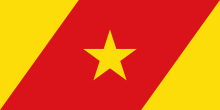Kuarit
Kuarit (Amharic: ቋሪት ) is one of the woredas in the Amhara Region of Ethiopia. Part of the Mirab Gojjam Zone, Kuarit is bordered on the southwest by Jabi Tehnan, on the west by Sekela, on the north by Yilmana Densa, on the east by the Misraq Gojjam Zone, and on the southeast by Dega Damot. The major town in Kuarit is Gebeze Mariam. Goncha woreda was separated from Kuarit.
Kuarit ቋሪት | |
|---|---|
Woreda | |
 Flag | |
| Zone | Mirab Gojjam |
| Region | Amhara Region |
| Area | |
| • Total | 602.99 km2 (232.82 sq mi) |
| Population (2012 est.) | |
| • Total | 124,309 |
The highest point in this woreda and in the West Gojjam Zone is Mount Amedamit , a part of the Choqa Mountains, with an elevation of 3619 meters. Mount Adama, from which the river Birr one of the tributaries of Blue Nile river starts its flow is one of the highest picks in the woreda. It was at the foot of this mountain that the Battle of Amedamit was fought on 6 October 1620 between Ras Sela Kristos, half-brother of the Emperor Susenyos of Ethiopia, and a group of rebels who opposed Susenyos' Pro-Catholic beliefs. The rebels were crushed.[2]
Demographics
Based on the 2007 national census conducted by the Central Statistical Agency of Ethiopia (CSA), this woreda has a total population of 114,771, an increase of -16.49% over the 1994 census, of whom 56,767 are men and 58,004 women; 4,750 or 4.14% are urban inhabitants. With an area of 602.99 square kilometers, Kuarit has a population density of 190.34, which is greater than the Zone average of 158.25 persons per square kilometer. A total of 25,402 households were counted in this woreda, resulting in an average of 4.52 persons to a household, and 24,927 housing units. The majority of the inhabitants practiced Ethiopian Orthodox Christianity, with 99.96% reporting that as their religion.[3]
The 1994 national census reported a total population for this woreda of 137,437 in 27,875 households, of whom 69,044 were men and 68,393 were women; 2,008 or 1.46% of its population were urban dwellers. The largest ethnic group reported in Kuarit was the Amhara (99.95%). Amharic was spoken as a first language by 99.9%. The majority of the inhabitants practiced Ethiopian Orthodox Christianity, with 99.9% reporting that as their religion.[4]
Notes
- Geohive: Ethiopia Archived 2012-08-05 at the Wayback Machine
- this battle is described in James Bruce 'Travels to Discover the Source of the Nile (1805 edition), vol. 3, pp. 353-355
- Census 2007 Tables: Amhara Region Archived November 14, 2010, at the Wayback Machine, Tables 2.1, 2.4, 2.5, 3.1, 3.2 and 3.4.
- 1994 Population and Housing Census of Ethiopia: Results for Amhara Region, Vol. 1, part 1 Archived November 15, 2010, at the Wayback Machine, Tables 2.1, 2.7, 2.10, 2.13, 2.17, Annex II.2 (accessed 9 April 2009)